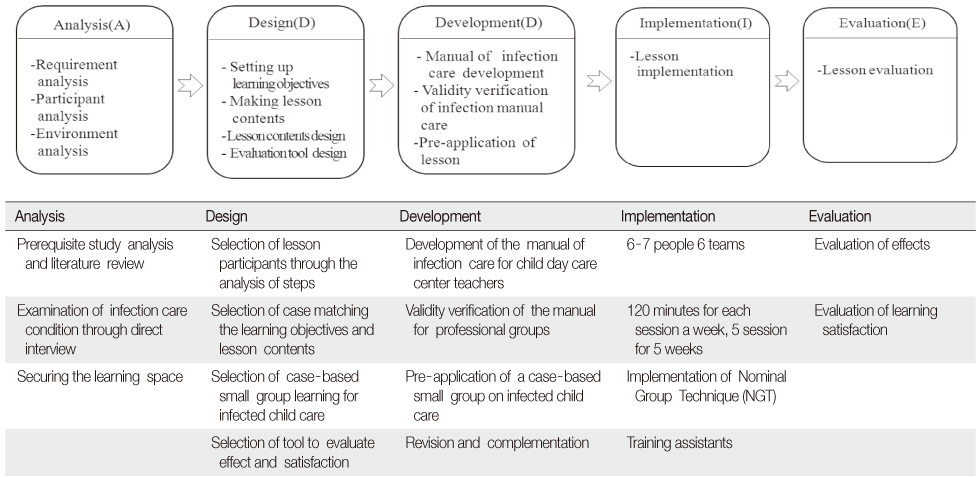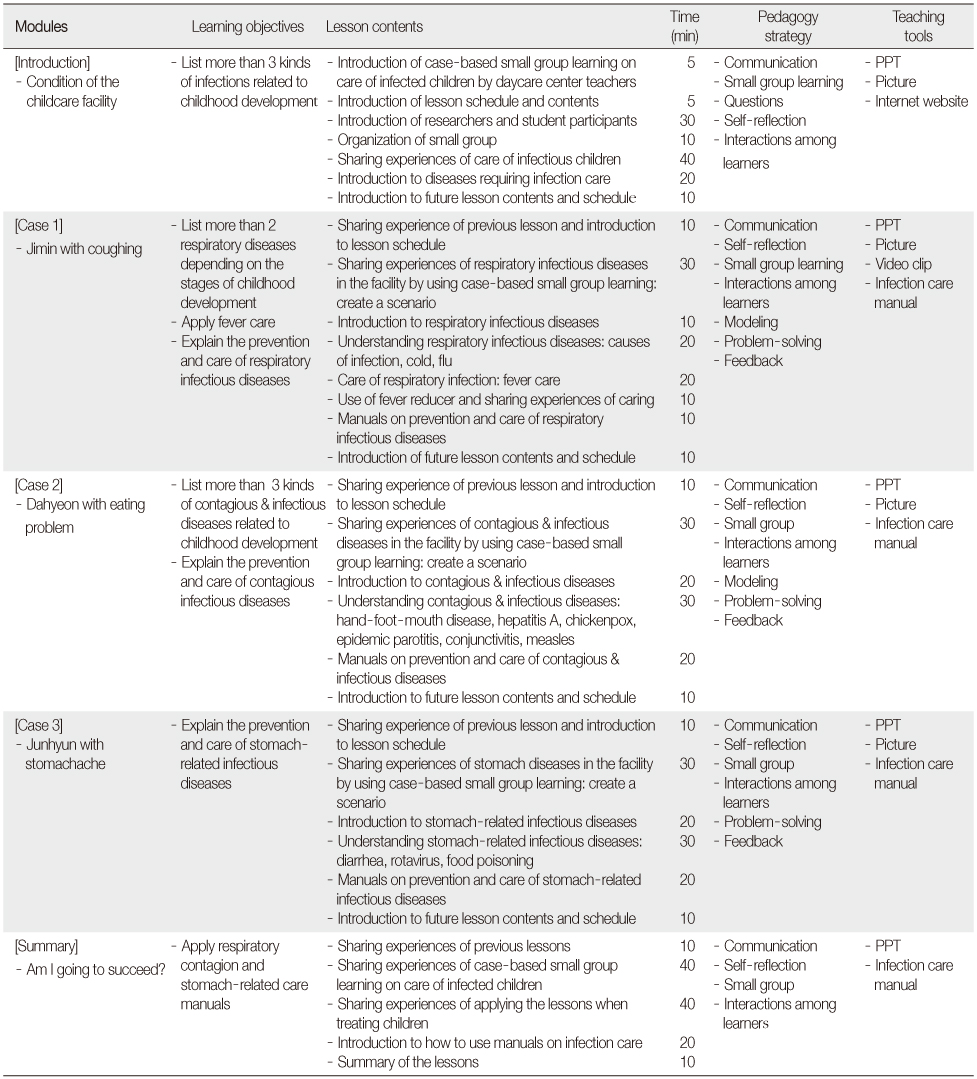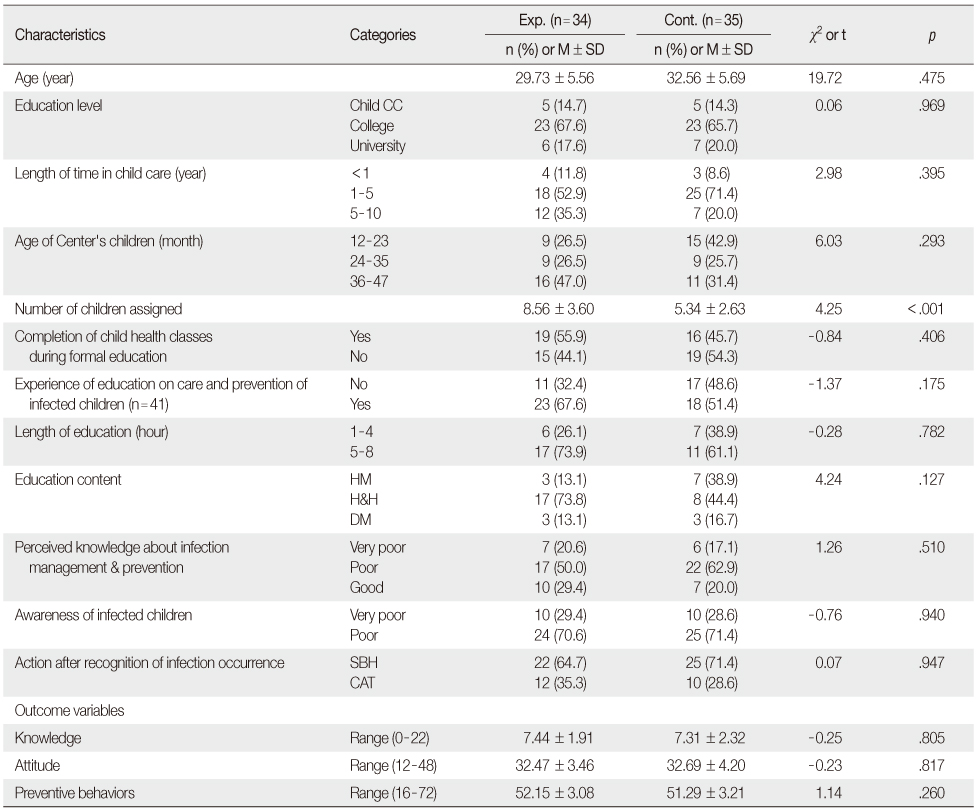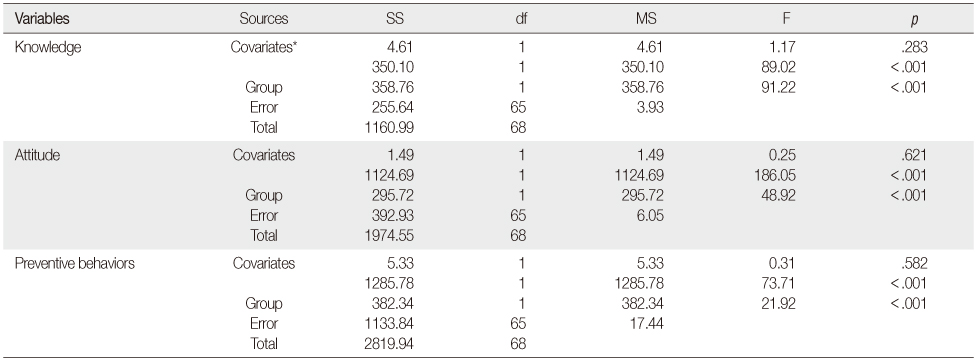Articles
- Page Path
- HOME > J Korean Acad Nurs > Volume 42(6); 2012 > Article
-
Original Article
- Effects of Case-based Small Group Learning about Care of Infected Children for Daycare Center Teachers
- Eun Ju Choi, Seon Young Hwang
-
Journal of Korean Academy of Nursing 2012;42(6):771-782.
DOI: https://doi.org/10.4040/jkan.2012.42.6.771
Published online: December 31, 2012
1Department of Nursing, Cheongam College, Sunchoen, Korea.
2Department of Nursing, Hanyang University, Seoul, Korea.
- Address reprint requests to: Hwang, Seon Young. Department of Nursing, Hanyang University, 222 Wangsimni-ro, Seongdong-gu, Seoul, Korea. Tel: +82-2-2220-0702, Fax: +82-2-2220-0702, seon9772@hanyang.ac.kr
© 2012 Korean Society of Nursing Science
- 789 Views
- 8 Download
- 7 Crossref
Abstract
-
Purpose
- This study was conducted to develop and implement a case-based small group learning program on the care of children with infectious disease, and to examine its effects on knowledge, attitude and preventive practice behaviors of daycare center teachers compared to a control group.
-
Methods
- Based on the need assessment, the case-based learning program for the management of infectious children was developed. For this quasi-experimental study, 69 teachers were recruited from 14 child daycare centers in a city located in J province. Thirty four teachers were assigned to experimental group and participated in the case-based small group learning once a week for 5 weeks. Data were analyzed using the SPSS 18.0 program to perform χ2-test and t-tests. Analysis of covariance was used to treat the covariate of the number of assigned children between experimental and control groups.
-
Results
- The experimental group showed significantly higher posttest scores in knowledge, attitude and preventive practice behaviors than those of control group (p<.001).
-
Conclusion
- These findings indicate that case-based small group learning is an effective educational strategy for daycare center teachers to learn infection management through the emphasis of self-reflection and discussion.
- 1. Benfield JP. The effect of a teaching program on infection prevention behavior in day care center staff members. 1991;Washington D. C., USA, The Catholic University. Unpublished doctoral dissertation.
- 2. Crowley AA, Kulikowich JM. Impact of training on child care health consultant knowledge and practice. Pediatr Nurs. 2009;35:93–100.PubMed
- 3. Hagerhed-Engman L, Bornehag CG, Sundell J, Aberg N. Day-care attendance and increased risk for respiratory and allergic symptoms in preschool age. Allergy. 2006;61:447–453. http://dx.doi.org/10.1111/J.1398-9995.2006.01031.x.ArticlePubMed
- 4. Faul F, Erdfelder E, Buchner A, Lang AG. Statistical power analysis using G*Power 3.1: Tests for correlation and regression analyses. Behav Res Methods. 2009;41:1149–1160. http://dx.doi.org/10.3758/BRM.41.4.1149.PubMed
- 5. Fukkink RG, Tavecchio LW. Effects of video interaction guidance on early childhood teachers. Teach Teach Educ. 2010;26:1652–1659. http://dx.doi.org/10.1016/j.tate.2010.06.016.Article
- 6. Gupta RS, Shuman S, Taveras EM, Kulldorff M, Finkelstein JA. Opportunities for health promotion education in child care. Pediatrics. 2005;116:e499–e505. Advanced online publication. http://dx.doi.org/10.1542/peds.2005-0467.ArticlePubMedPDF
- 7. Han KJ, Bang KS, Kwon MK, Kim JS, Choi MY, Huh BY. Development of visiting nurses service model in child day-care centers. J Korean Soc Matern Child Health. 2010;14:57–73.Article
- 8. Han KJ, Kim JS, Choi MY. Needs of day-care staff for a center-based child care health program II. J Korean Acad Child Health Nurs. 2007;13:128–135.
- 9. Kim HJ. The present situation of adjustment programs performed for young children in child care center. Early Child Educ Res Rev. 2010;14:443–470.
- 10. Kim JS. Effects of a training program on infection prevention for staff of child daycare centers. J Korean Acad Child Health Nurs. 2007;13:467–477.
- 11. Kim SJ, Yang SO, Lee SH, Lee JE, Kim SH, Kang KA. Development and evaluation of a child health care protocol for child day care center teachers. J Korean Acad Child Health Nurs. 2011;17:74–83. http://dx.doi.org/10.4094/jkachn.2011.17.2.74.Article
- 12. Korea Childcare Promotion Institute. Standard continuing education courses. 2010;03;Seoul, Author.
- 13. Kotch JB, Isbell P, Weber DJ, Nguyen V, Savage E, Gunn E, et al. Hand-washing and diapering equipment reduces disease among children in out-of-home child care centers. Pediatrics. 2007;120:e29–e36. http://dx.doi.org/10.1542/peds.2005-0760.ArticlePubMedPDF
- 14. Lee EJ. Teachers' awareness and their role performance on preschoolers' health management. 2011;Daejeon, Chungnam National University. Unpublished master' thesis.
- 15. Lim NY, Kim JH, Chon JJ, Jung MH, Kim BH, Yoo EK, et al. Development model of child health promotion center. Korean Nurse. 2003;42(5):74–82.
- 16. Michaelsen LK, Parmelee DX, McMahon KK, Levine RE. Team-based learning for health professions education- a guide to using small groups for improving learning-. 2007;Sterling, VA, Stylus Publishing.
- 17. inistry of Health and Welfare. 2009 Statistics on child care programme (Issue Brief No. 11-1351000-000016-10). 2010;05 24 Seoul, Author.
- 18. Ministry of Health and Welfare. Early childhood care law. 2012;02 03 Retrieved March 30, 2012. from http://www.lawnb.com/lawinfo/contents_view.asp?cid=C39B5D1A899A49FC8C5D08904AD3ADF2|0|K.
- 19. Oh KS, Sim MK, Choi EK. Effect of an education program on child health and safety for child care teachers. J Korean Acad Child Health Nurs. 2009;15:5–14. http://dx.doi.org/10.4094/jkachn.2009.15.1.5.Article
- 20. Park SN, Lee YR, Joung YJ, Kim KM. Knowledge and management of children with infectious disease by daycare facility teachers. J Korean Acad Public Health Nurs. 2010;24:115–125.
- 21. Roberts L, Smith W, Jorm L, Patel M, Douglas RM, McGlichrist C. Effect of infection control measures on the frequency of upper respiratory infection in child care: A randomized controlled trial. Pediatrics. 2000;105:738–742. http://dx.doi.org/10.1542/peds.105.4.738.ArticlePubMedPDF
- 22. Ryu CS, Ji OJ, Yoon SY. A study on the role taking of the in-service educator to increase the self-reflection in group for kindergarten teachers. J Korea Open Assoc Early Child Educ. 2001;6:107–124.
- 23. Taveras EM, Lapelle N, Gupta RS, Finkelstein JA. Planning for health promotion in low-income preschool child care settings: Focus groups of parents and child care providers. Ambul Pediatr. 2006;6:342–346. http://dx.doi.org/10.1016/j.ambp.2006.07.004.ArticlePubMed
- 24. Uhari M, Mottonen M. An open randomized controlled trial of infection prevention in child day-care centers. Pediatr Infect Dis J. 1999;18:672–677.ArticlePubMed
REFERENCES



Figure & Data
REFERENCES
Citations

- A qualitative content analysis based on an extended parallel process model study of daycare center teacher behaviors concerning the eye health of preschool children
Il Tae Park, Gi Joong Kim
The Journal of Korean Academic Society of Nursing Education.2024; 30(3): 222. CrossRef - Effect of Visiting and a Smartphone Application Based Infection Prevention Education Program for Child Care Teachers: A Non-Randomized Controlled Trial
Yun Jeong Yang, In Soo Kwon
Journal of Korean Academy of Nursing.2017; 47(6): 744. CrossRef - The Influence of Case-Based Learning using video In Emergency care of infant and toddlers
Hye-Young Cho, Kyoung-Ah Kang
Journal of the Korea Academia-Industrial cooperation Society.2016; 17(12): 292. CrossRef - Factors Affecting Daycare Center Teachers’ Management of Childhood Fever
Song I Park, Jin Sun Kim
Child Health Nursing Research.2016; 22(4): 289. CrossRef - The Effects of Case-Based Learning (CBL) on Learning Motivation and Learning Satisfaction of Nursing Students in a Human Physiology Course
Na Hyun Kim, Ji Yeon Park, Sang Eun Jun
Journal of Korean Biological Nursing Science.2015; 17(1): 78. CrossRef - Effects of Case-based Small Group Learning on Daycare Center Teachers' Coping Ability in Emergency Situations: Focus on Daily Life and Cardiopulmonary Resuscitation.
Eun Ju Choi
Child Health Nursing Research.2013; 19(3): 168. CrossRef - Effects of an Infection Prevention Education Program in Infant and Child for Married Immigrant Vietnamese Women
Ji-young Seo, Eun Young Kim
Korean Journal of Adult Nursing.2013; 25(4): 422. CrossRef

Figure 1
Composition and Contents of the Outline of Case-based Small Group Learning on Care of Infected Children
PPT=Powerpoint template.
Homogeneity Test of Sample Charactristics and Outcome Variables between the Experimental and Control Groups (N=69)
Exp.=Experimental group; Cont.=Control group; HM=Health management; Child CC=Child care certification; H&H=Health & hygiene;
DM=Disease management in childhood; SBH=Send to back home; CAT=Consult with another teacher.
Analysis of Covariance (ANCOVA) for Knowledge, Attitude, and Preventive Behaviors (N=69)
*The covariates are number of assigned children and pre-test score.
Differences in Dependent Variables between the Experimental and Control Groups
Exp.=Experimental group; Cont.=Control group.
PPT=Powerpoint template.
Exp.=Experimental group; Cont.=Control group; HM=Health management; Child CC=Child care certification; H&H=Health & hygiene; DM=Disease management in childhood; SBH=Send to back home; CAT=Consult with another teacher.
*The covariates are number of assigned children and pre-test score.
Exp.=Experimental group; Cont.=Control group.
 KSNS
KSNS
 E-SUBMISSION
E-SUBMISSION


 Cite
Cite

